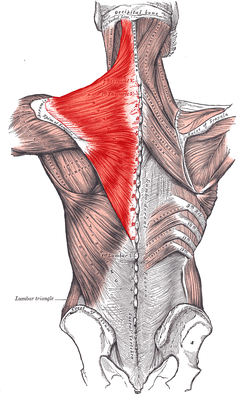Trapezius muscle
| Trapezius | |
|---|---|

trapezius
|
|

muscles connecting the upper extremity to the vertebral column; trapezius is labeled at upper left.
|
|
| Details | |
| Origin |
spinous processes of vertebrae C7-T12,Nuchal ligament, Occipital Bone |
| Insertion | external occipital protuberance, nuchal ligament, medial superior nuchal line, posterior border of the lateral third of the clavicle, acromion process, and spine of scapula |
| Artery | superficial branch of transverse cervical artery or superficial cervical artery |
| Nerve |
accessory nerve (motor) cervical spinal nerves C3 and C4 (motor and sensation) |
| Actions | rotation, retraction, elevation, and depression of scapula |
| Antagonist | serratus anterior muscle, Latissimus dorsi |
| Identifiers | |
| Latin | musculus trapezius |
| TA | A04.3.01.001 |
| FMA | 9626 |
|
Anatomical terms of muscle
[]
|
|
spinous processes of vertebrae C7-T12,Nuchal ligament,
In human anatomy, the trapezius (/trəˈpiːzi.əs/) is one of two large superficial muscles that extend longitudinally from the occipital bone to the lower thoracic vertebrae and laterally to the spine of the scapula (shoulder blade). Its functions are to move the scapulae and support the arm.
The trapezius has three functional regions: the superior region (descending part), which supports the weight of the arm; the intermediate region (transverse part), which retracts the scapulae; and the inferior region (ascending part), which medially rotates and depresses the scapulae.
The trapezius muscle resembles a trapezium (trapezoid in American English), or diamond-shaped quadrilateral. The word "spinotrapezius" refers to the human trapezius, although it is not commonly used in modern texts. In other mammals, it refers to a portion of the analogous muscle.
The superior or upper (or descending) fibers of the trapezius originate from the spinous processes of C7, the external occipital protuberance, the medial third of the superior nuchal line of the occipital bone (both in the back of the head), and the ligamentum nuchae. From this origin they proceed downward and laterally to be inserted into the posterior border of the lateral third of the clavicle.
...
Wikipedia
